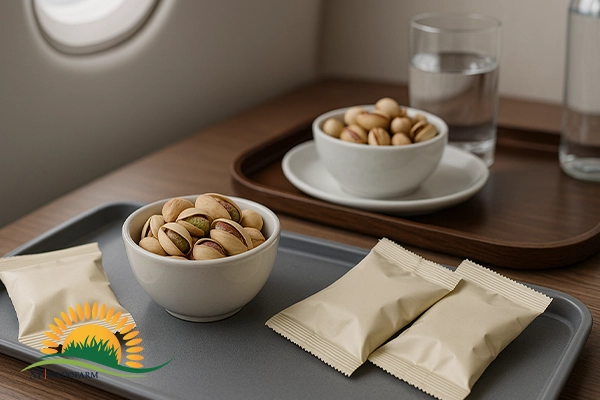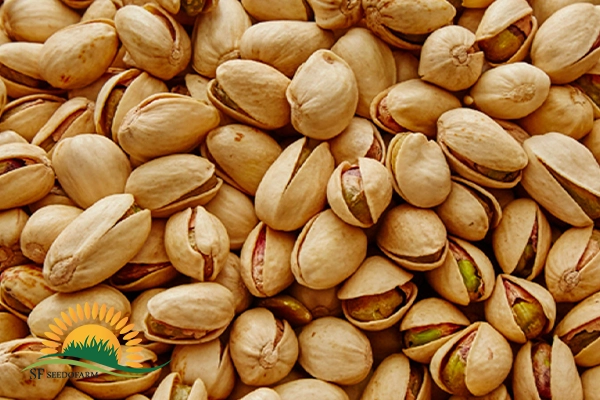Winning tenders with foodservice pistachios depends on three things: compliant formats (20–30 g amenity packs, 1 kg kitchen packs, 10 kg bulk), clean and consistent roasting, and bulletproof paperwork. Airlines want portion-controlled airline catering nuts with sodium caps and tamper-evident seals; hotels prefer premium yet cost-stable hotel amenities snacks with long shelf life, multilingual labels, and HACCP/aflatoxin documentation ready to file.
Introduction: How Hotel & Airline Tenders Work
Hospitality procurement is formal, deadline-driven, and risk-averse. Buyers evaluate:
- Compliance first: allergens, labeling, certifications, and aflatoxin controls.
- Format fit: correct portion sizes, pack counts per case, and pallet pattern.
- Consistency: stable flavor, color, and crunch across months and routes.
- Total landed cost: price + freight + spoilage risk + handling time.
This guide shows exactly how to structure foodservice pistachios so you qualify fast, pass audits, and scale supply without surprises.
Buyer Requirements Checklist (Pass/Fail Items)
Use this list when preparing samples and quotes for airline catering nuts and hotel amenities snacks.
Documentation
- HACCP statement (or GFSI-recognized system), COA per lot, aflatoxin test results.
- Country of origin, HS code, allergens (“Contains tree nuts”), storage & best-before.
- Lot traceability from orchard to carton.
Product specs
- Counts (pcs/oz) declared; typical: Round 30–32, 32–34; Ahmad Aghaei 24–26; Jumbo 20–22.
- Moisture target ≤ 5% finished; split ratio limits; defect limits per 1,000 g.
- Roasting level (light/medium) and sodium target per sachet.
Packaging
- Tamper-evident, food-grade films; nitrogen-flushed or vacuum as required.
- Barcode/lot on each inner and outer.
- Case pack counts aligned to service flow (e.g., 200 × 25 g; 10 × 1 kg; 2 × 10 kg).
Operations
- Lead time (production + transit), MOQ, buffer stock, and shelf-life at destination.
- Temperature tolerance across lanes (tarmac/warehouse/galley or minibar).
- Recall procedure and contacts 24/7.
If any item above is missing, most tenders will cut you before tasting.
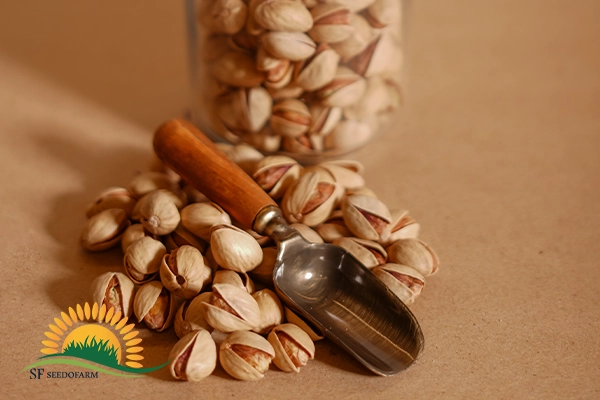
The 9 Winning SKUs (Formats & Portion Sizes)
These formats cover 90% of hospitality needs. All are available as raw, lightly salted, or roasted & salted; seasoning variants only if approved by the buyer.
- Amenity Sachet 20 g – Ultra-compact for short-haul service; sodium cap ≤ 180–220 mg.
- Amenity Sachet 25 g – Most common single-serve for airline catering nuts; strong value.
- Amenity Sachet 30 g – Premium or business-class portion; often used by hotels in welcome kits.
- Amenity Duo 2×20 g – Perforated twin-pack (shareable, reduces open-pack waste).
- Bar & Lounge 50 g – For hotel bars; peg-ready or box-dispensed.
- Kitchen Pack 1 kg – Back-of-house for salads, pilaf, desserts; zipper and date window.
- Kernel Pack 1 kg – Shelled kernels for pastry/ice cream stations; color-graded.
- Bulk Foodservice 10 kg (vacuum) – Cafés, banquets; fastest turn and best cost base.
- Mixed Nut Hospitality Blend (1 kg / 10 kg) – Pre-balanced mix with pistachio lead share (e.g., 30–40%) to hit price points without losing premium perception.
Variety guidance
- Amenity sachets: Round 30–32 or 32–34 for more pieces per pack; Ahmad Aghaei for premium look.
- Bar & lounge: Ahmad Aghaei or Jumbo for visual impact.
- Kitchen & bulk: Round kernels (bright color) for predictable yield.
Packaging & Compliance for Travel & Hospitality
Packaging is where tenders are won or lost.
For sachets (20–30 g)
- Multilayer oxygen-barrier film, nitrogen-flushed; residual O₂ as low as practical.
- Fin or lap seal with visible tamper evidence; easy-open notch.
- Front: product name + net weight. Back: ingredients, allergens, nutrition (if required), storage, best-before, lot, barcode.
For 1 kg packs
- Stand-up pouch with zipper, window optional; nitrogen flush recommended.
- Clear date/lot; scannable barcode for storerooms.
For 10 kg bulk
- Food-grade vacuum bag inside reinforced master carton; pallet pattern printed (cases/layer × layers/pallet).
- Moisture barrier liner if routes are humid.
Labeling & claims
- Avoid “health” claims unless substantiated for the destination.
- Use neutral, service-friendly copy: “Roasted & Salted Pistachios — Ready to Serve.”
- Provide a “sodium per serving” statement; many airlines target ≤ 230 mg for economy.
Shelf life targets
- Sachets: 10–12 months (nitrogen).
- 1 kg/10 kg: 9–12 months (vacuum or nitrogen + cool storage).
Quality Specs That Pass Audits
Auditors don’t negotiate. Put these into your spec sheet for foodservice pistachios:
- Counts (pcs/oz): Round 30–32 / 32–34 for sachets; Ahmad Aghaei 24–26 for premium amenity; Jumbo 20–22 for lounge service.
- Split ratio: ≥ 90% open-mouth (amenity packs), ≥ 92% for premium/lounge.
- Pistachio moisture (finished): ≤ 5.0% (target 3.8–4.5% for crisp bite).
- Defects, per 1,000 g: Closed/empty ≤ 1.0%; foreign matter = 0; shell staining ≤ 0.5%.
- Aflatoxin: Certificate per lot (per destination legal limits).
- Salt/sodium: Declare mg per sachet; meet airline caps (typ. ≤ 180–230 mg/25 g).
- Allergens/labeling: “Contains tree nuts.” Country of origin, HS code, storage, best-before, lot traceability.
Tip: attach a one-page “Audit Ready” appendix with COA sample, aflatoxin report, HACCP statement, and traceability map (orchard → carton).
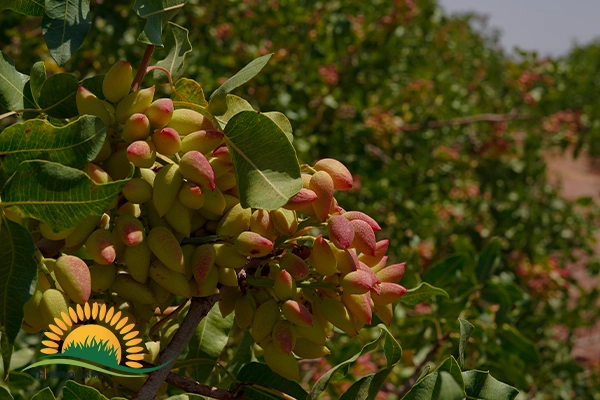
Roasting & Seasoning Profiles for Service
You need consistent color and a clean crunch across months and routes.
Baseline roast (amenity sachets):
- Medium roast, 145–155 °C, 9–12 min (air roaster) or 7–10 min (drum).
- Finish at 3.8–4.3% moisture; forced-air cool to < 40 °C before packing.
Low-sodium line:
- Light roast + micro-coat (0.8–1.0% oil mist) + fine salt; keeps sodium within airline thresholds.
Premium lounge line:
- Two-stage roast for Jumbo/AA to control carryover; optional lemon-salt or mild spice.
- Avoid sticky glazes in aircraft galleys—go for clean-label dry blends.
Kernels (1 kg kitchen packs):
- Slightly lighter roast to protect color for pastry/ice cream.
- Target pistachio moisture 4.2–4.8% to resist crumbling during folding/mixing.
Logistics, Shelf Life & Stability
Lead times: production 10–15 days + transit; propose buffer stock near main hubs.
Thermal reality: tarmac and galley cycles stress seals. Choose film/barrier that tolerates 35–45 °C spikes.
Case & pallet pattern: print cases/layer × layers/pallet on the master; keep it consistent for airline caterers.
Shelf life: sachets 10–12 months (nitrogen); 1 kg/10 kg 9–12 months (vacuum/nitrogen in cool storage).
Stability checks: residual O₂ (for nitrogen packs), seal integrity, transport drop tests.
Pricing, Bid Strategy & Tiered Options
Win tenders by giving buyers a ladder:
- Good: Round 32–34, 25 g sachet, light salt—best cost/portion for airline catering nuts.
- Better: Ahmad Aghaei 24–26, 25–30 g sachet—premium look for business class.
- Best: Jumbo 20–22, 30 g sachet or 50 g lounge pack—flagship for lounges/hotels.
Add-ons that close deals:
- Rebate for annual volume bands.
- Free sampler kit (9 SKUs) for route tests.
- Mixed-nut hospitality blend at the same case size to hit tricky price points.
Samples, QA Protocol & Approvals
Pre-approval flow:
- Send labeled samples with batch record and COA.
- Include roasting profile, moisture target, sodium per sachet.
- Provide three months of retention samples (kept at buyer or caterer).
- Agree on acceptance criteria and CAPA if any parameter drifts.
Ongoing QA: lot COAs, aflatoxin reports, and traceability files sent automatically with invoices or ASN.
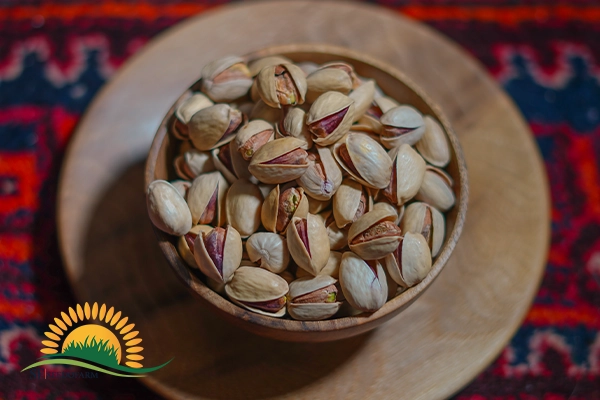
Case-Ready Assets Buyers Expect
- Spec sheets (PDF + editable), HS code, GTIN/UPC/EAN, carton dims/weights.
- Certificates bundle: HACCP statement or GFSI-equivalent, aflatoxin test, country-of-origin.
- Marketing assets: high-res product images on white, front/back sachet shots, lifestyle images for hotel amenities snacks.
- Regulatory: multilingual label templates, nutrition panel (if required), allergen statement.
Conclusion & Contact
Winning hotel and airline tenders means aligning format, flavor, and files—not just price. Build amenity sachets with tight specs, run stable roast curves, keep pistachio moisture under control, and arrive with audit-ready paperwork. With those boxes checked, foodservice pistachios become a repeatable program for airline catering nuts and hotel amenities snacks across regions.
How to source: We don’t sell directly online. Submit your inquiry via the Contact page with target SKUs, counts, packaging, and volumes, and we’ll reply with specifications, samples, and a tailored quotation.
FAQ:
What sizes work best for economy service?
25 g sachets of Round (30–32 or 32–34) balance cost, piece count, and crunch.
What’s the ideal finished moisture?
For foodservice pistachios, target ≤ 5%; 3.8–4.3% gives a crisp bite and stable shelf life.
Do airlines accept flavored nuts?
Yes—mainly light salt or lemon-salt. Strong spices or sticky glazes can be rejected due to mess and odor.
How do hotels use kernels?
1 kg packs of bright kernels for pastry, gelato, and salad bars; lighter roast preserves color.
What documents are mandatory?
COA per lot, aflatoxin report, HACCP statement (or GFSI equivalent), origin, HS code, and traceability.

